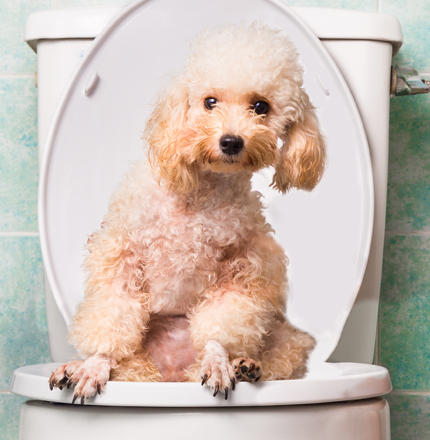How do you actually feel in regards to Why you should never flush dog poop down the toilet?

When it pertains to throwing away waste, specifically animal waste, many individuals usually turn to the practical choice of flushing it down the toilet. However, this relatively easy option can have significant consequences for the setting and public health. In this short article, we'll discover why flushing pet waste down the toilet is a negative concept and offer different approaches for correct disposal.
Intro
Proper waste disposal is important for preserving ecological sustainability and public health. While it may appear safe to purge animal waste down the toilet, it can lead to different problems, both for the setting and human well-being.
Threats of flushing animal waste
Ecological influence
Flushing animal waste presents unsafe bacteria and pathogens right into rivers, which can adversely affect water environments. These pathogens can infect water sources and injury marine life, interfering with delicate ecological communities.
Public health worries
Animal waste consists of harmful germs such as E. coli and Salmonella, which can posture major health and wellness threats to humans. Flushing animal waste down the commode can infect water supplies, resulting in the spread of illness and infections.
Alternatives to flushing
As opposed to flushing pet waste down the commode, there are numerous different disposal methods that are much more environmentally friendly and hygienic.
Composting
Composting animal waste is an environment-friendly method to take care of it. By get more info composting, raw material is broken down into nutrient-rich soil, which can be utilized to fertilize gardens and plants.
Land fill disposal
Getting rid of animal waste in a landfill is another alternative. While not as eco-friendly as composting, it is a safer choice to flushing, as it protects against the contamination of water sources.
Animal garbage disposal systems
There are customized animal garbage disposal systems readily available that securely and hygienically take care of animal waste. These systems usually make use of enzymes to break down waste and get rid of smells.
Actions to appropriate animal waste disposal
To ensure proper disposal of pet waste, follow these actions:
Scooping and nabbing waste
Routinely scoop and bag animal waste utilizing biodegradable bags. This prevents waste from polluting the atmosphere.
Making use of marked waste containers
Dispose of bagged pet waste in marked waste containers, such as compost containers or land fill bins. Stay clear of flushing it down the toilet whatsoever costs.
Cleaning up litter boxes and animal areas frequently
Frequently clean litter boxes and family pet locations to prevent the build-up of waste and germs. Use pet-safe cleansing products to maintain health.
Benefits of appropriate disposal approaches
Adopting correct disposal methods for pet waste offers a number of advantages:
Decreased environmental pollution
Correct disposal methods minimize the risk of environmental pollution, safeguarding rivers and ecosystems from contamination
Lessened threat of water contamination.
By staying clear of flushing animal waste down the bathroom, the danger of water contamination is dramatically reduced, protecting public health.
Enhanced cleanliness and hygiene
Proper disposal methods promote much better cleanliness and hygiene, creating a more secure atmosphere for both people and animals.
Final thought
In conclusion, flushing animal waste down the bathroom is unsafe to the environment and public health. By embracing alternate disposal methods and following correct waste administration techniques, we can decrease the adverse impact of pet waste and contribute to a cleaner, healthier world.
What To Do With Dog Poo – The Do's And Don'ts Of Disposing Of Faeces
Dog poo bins
Some councils provide dedicated dog waste bins in popular dog-walking areas that can take dog poo that has been bagged but you can legally dispose of dog waste in any public litter bin, as long as it is securely bagged. This also applies to your wheelie bin at home.
Do not flush
Water companies do not recommend flushing dog faeces down the toilet because certain parasites can survive the water processing treatment and are potentially harmful to humans. You should also never consider flushing dog poo that has been bagged down the toilet as the bags will not break down and instead create severe blockages in the sewage system.
In the woods
The Forestry Commission promotes a ‘stick and flick’ method for dealing with waste in the woods. This means finding a stick and using it to flick any poo from off the path so that it is out of the way of other walkers. You could also bury it as long as it is not in an area where there might be livestock.
Livestock
Parasites found in dog poo can be transmitted to livestock if they inadvertently eat infected faeces that has been left on grazing land. This could result in the death of sheep or abortion in cattle so you should always make sure you pick up your dog’s waste in fields where livestock could be present.

Frequently clean litter boxes and family pet locations to prevent the build-up of waste and germs. Use pet-safe cleansing products to maintain health.
Benefits of appropriate disposal approaches
Adopting correct disposal methods for pet waste offers a number of advantages:
Decreased environmental pollution
Correct disposal methods minimize the risk of environmental pollution, safeguarding rivers and ecosystems from contamination
Lessened threat of water contamination.
By staying clear of flushing animal waste down the bathroom, the danger of water contamination is dramatically reduced, protecting public health.
Enhanced cleanliness and hygiene
Proper disposal methods promote much better cleanliness and hygiene, creating a more secure atmosphere for both people and animals.
Final thought
In conclusion, flushing animal waste down the bathroom is unsafe to the environment and public health. By embracing alternate disposal methods and following correct waste administration techniques, we can decrease the adverse impact of pet waste and contribute to a cleaner, healthier world.
What To Do With Dog Poo – The Do's And Don'ts Of Disposing Of Faeces
Dog poo bins
Some councils provide dedicated dog waste bins in popular dog-walking areas that can take dog poo that has been bagged but you can legally dispose of dog waste in any public litter bin, as long as it is securely bagged. This also applies to your wheelie bin at home.
Do not flush
Water companies do not recommend flushing dog faeces down the toilet because certain parasites can survive the water processing treatment and are potentially harmful to humans. You should also never consider flushing dog poo that has been bagged down the toilet as the bags will not break down and instead create severe blockages in the sewage system.
In the woods
The Forestry Commission promotes a ‘stick and flick’ method for dealing with waste in the woods. This means finding a stick and using it to flick any poo from off the path so that it is out of the way of other walkers. You could also bury it as long as it is not in an area where there might be livestock.
Livestock
Parasites found in dog poo can be transmitted to livestock if they inadvertently eat infected faeces that has been left on grazing land. This could result in the death of sheep or abortion in cattle so you should always make sure you pick up your dog’s waste in fields where livestock could be present.

We are very interested in Why you should never flush dog poop down the toilet and I am assuming you enjoyed the piece. Sharing is caring. Helping others is fun. We cherish reading our article about 4 Reasons Why Dog Poop Cleanup is Important.
Click Here